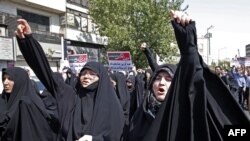Iran has rebuked Britain and Norway over what it claimed was interference and hostile news coverage of the extensive unrest in Iran triggered by the death of a young woman held in captivity by the country’s morality police for failing to properly wear a hijab, the semi-official IRNA news agency said Sunday.
Iran’s Foreign Ministry summoned the British and Norwegian ambassadors Saturday to deliver the protests to the envoys.
Tehran cited the “hostile character” of the London-based Persian language media, while complaining to the Norwegian diplomat about the "interventionist stance" of the country's parliamentary speaker, who has expressed support for the protesters on Twitter.
Demonstrations erupted more than a week ago across Iran, with protesters angered by the death on September 16 of a 22-year-old Kurdish woman, Mahsa Amini. It was the biggest wave of protests against the government in years.
Jake Sullivan, U.S. President Joe Biden’s national security adviser, told ABC’s “This Week” show on Sunday that the Iranian protests “reflect a widespread belief that [the demonstrators] deserve their dignity and rights” and that the U.S. supports them.
He said the U.S. supports people “who stand up for their rights.”
Iran’s judiciary chief, Gholamhossein Mohseni Ejei, on Sunday "emphasized the need for decisive action without leniency" against the core instigators of the "riots," the judiciary's Mizan Online website said, according to Agence France-Presse.
European Union foreign policy chief Josep Borrell said Sunday that Iran's crackdown on protests is "unjustifiable" and "unacceptable," as Tehran vowed no leniency against the unrest gripping the country, AFP reported.
In a statement on behalf of the EU, Borrell said moves "to severely restrict internet access by the relevant Iranian authorities and to block instant messaging platforms is a further cause for concern, as it blatantly violates freedom of expression.”
Some Iranian women have publicly cut their hair or burned their headscarves in the streets as angry crowds have called for the downfall of Supreme Leader Ayatollah Ali Khamenei.
Iran’s state television says 41 people have been killed. The government has restricted internet and mobile services to prevent more news coverage of fires set in the streets and police clashes with demonstrators, arresting hundreds, media reported.
A member of the Basij, a volunteer force with Iran's Revolutionary Guard, was killed by protesters late Saturday in Tehran, semi-official Fars news agency reported Sunday, according to The Associated Press.
Twelve bank branches were destroyed in the unrest in recent days, and 219 ATMs have been damaged, Iranian officials say.
The activist Twitter account 1500tasvir late on Saturday carried videos of protests in Tehran's western district of Sattarkhan showing protesters gathered at a square chanting, "Don't be afraid, we're all in this together.” A motorcycle that apparently belonged to riot police burned in the background.
In a video posted on social media Saturday, youths in the northern city of Babol gathered at a university gate and tried to take down portraits of Khamenei and Ayatollah Ruhollah Khomeini, the founder of the Islamic Republic, while bystanders shouted, "Death to the dictator!"
Iranian President Ebrahim Raisi says he has ordered an investigation into the detention and death of Amini, who was arrested by police enforcing the Islamic Republic's restrictions on women's dress.
Raisi did not mention the Amini case during a speech last week at the United Nations General Assembly. Instead, he complained about what he said were human rights abuses in other countries, including in the United States, for its treatment of migrants trying to cross its southwest border into the country from Mexico and for deaths of criminal suspects in police custody.
Some material in this report came from The Associated Press, Agence France-Presse and Reuters.











